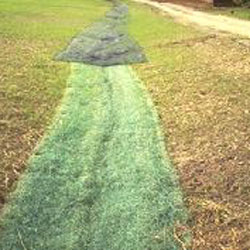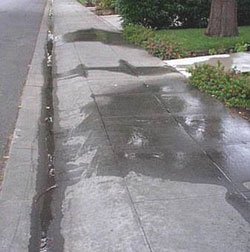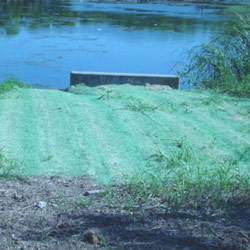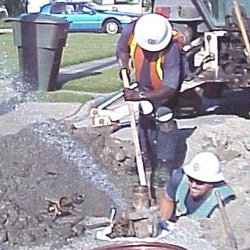Preventing Stormwater Pollution: Land Disturbances
Employees can help reduce water pollution by preventing dirt and debris from being washed into the storm drain system during the following activities:
- Utility repairs
- Water and sanitary sewer lines
- Storm drain systems
- Street repairs
- Sidewalk construction and repairs
- Landscaping (parks, building, medians)
- Power pole installation and replacement
Note: Projects that disturb more than one acre must comply with the state’s storm water permit for construction activities. If a permit is required, your supervisor or environmental coordinator will provide specific instructions.
What are potential construction site pollutants?
Potential pollutants on construction sites include soil, trash, debris, oil, grease, lime, concrete truck wash water, etc. Projects must be managed to prevent or reduce soil and other pollutants from entering storm drains, creeks, or lakes.
Definitions
Erosion - the removal or wearing away of soil due to water or wind.
Sediment - the soil that settles out of flowing water.

General Principles
- Preventing erosion is more effective than trying to remove sediment from runoff.
- Minimize the amount of disturbed area.
- Divert runoff or flowing water away from disturbed areas.
- Locate stockpiles out of the street and away from runoff or flowing water to prevent sediment from washing into storm drains.
- Cover stockpiles or provide a barrier such as an organic filter berm or silt fence around the pile.

Best Management Practices (BMPs)
- Erosion Control BMPs are used to protect disturbed soils from being washed away by rainfall or runoff.
- Sediment Control BMPs are used to trap sediment carried by runoff to keep it on the construction site.
- Waste Management BMPs are good housekeeping practices to control trash, chemicals, and debris.

Sediment Control BMPs
- 1 to 3 foot high berm of mulch and compost placed around a disturbed area.
- Silt fence - filter fabric trenched into the soil and attached to supporting posts.
- Triangular sediment dike - filter fabric \ placed over filter fabric placed over welded wire shaped into a triangle.
- Inlet protection - filter fabric or stone placed around or in front of a storm drain inlet.

Erosion Control BMPs
- Vegetation - grasses or other plants that provide permanent erosion protection.
- Mulching - a layer of straw or wood mulch.

Waste Management BMPs
- Debris and trash control - use covered trash cans, bins, and/or roll off boxes for disposing trash and debris.
- Chemical management - follow proper material storage and spill cleanup procedures for chemicals used on construction sites.
- Concrete washout - use designated facilities to capture wash water from concrete truck cleaning.